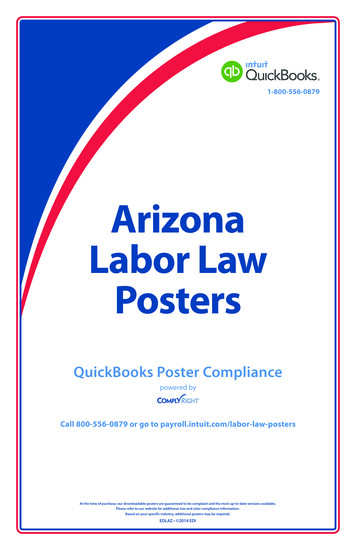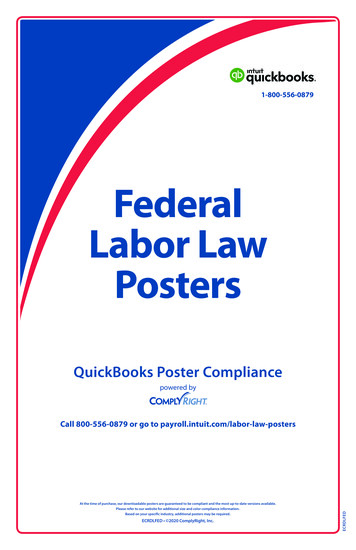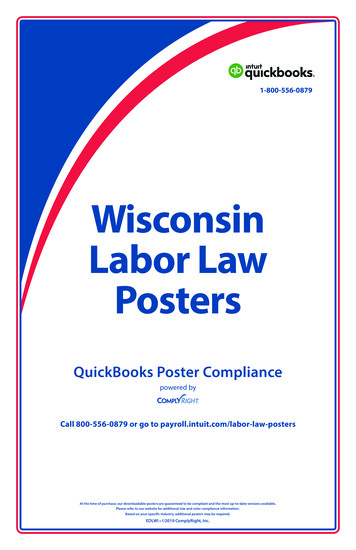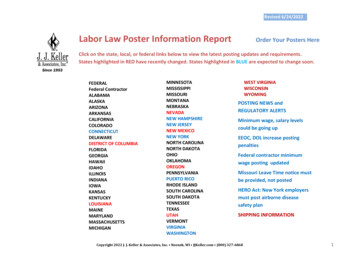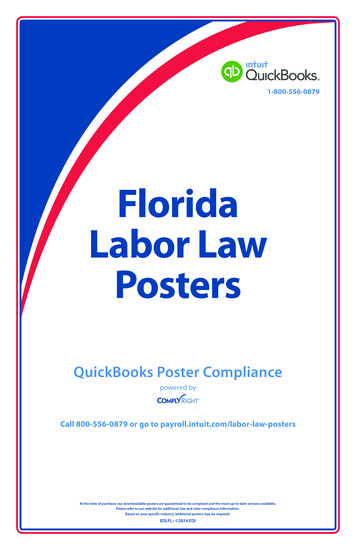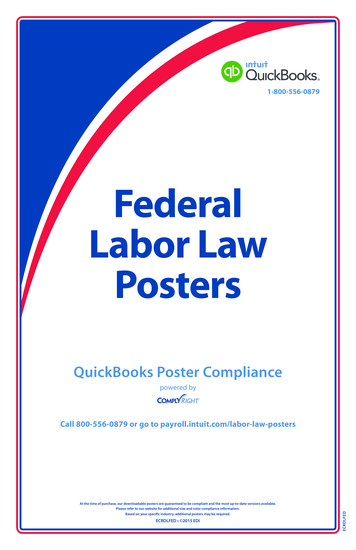
Transcription
1-800-556-0879FederalLabor LawPostersQuickBooks Poster Compliancepowered byAt the time of purchase, our downloadable posters are guaranteed to be compliant and the most up-to-date versions available.Please refer to our website for additional size and color compliance information.Based on your specific industry, additional posters may be required.ECRDLFED 2015 EDIECRDLFEDCall 800-556-0879 or go to payroll.intuit.com/labor-law-posters
EEOC U.S. Equal Employment Opportunity CommissionEqual Employment Opportunity isTHE LAWPrivate Employers, State and Local Governments,Educational Institutions, Employment Agenciesand Labor OrganizationsApplicants to and employees of most private employers, state and localgovernments, educational institutions, employment agencies and labororganizations are protected under Federal law from discrimination on thefollowing bases: RACE, COLOR, RELIGION, SEX, NATIONAL ORIGINTitle VII of the Civil Rights Act of 1964, as amended, protects applicants andemployees from discrimination in hiring, promotion, discharge, pay, fringe benefits,job training, classification, referral, and other aspects of employment, on the basisof race, color, religion, sex (including pregnancy), or national origin. Religiousdiscrimination includes failing to reasonably accommodate an employee’s religiouspractices where the accommodation does not impose undue hardship. DISABILITYTitle I and Title V of the Americans with Disabilities Act of 1990, as amended,protect qualified individuals from discrimination on the basis of disability inhiring, promotion, discharge, pay, fringe benefits, job training, classification,referral, and other aspects of employment. Disability discrimination includes notmaking reasonable accommodation to the known physical or mental limitationsof an otherwise qualified individual with a disability who is an applicant oremployee, barring undue hardship. AGEThe Age Discrimination in Employment Act of 1967, as amended, protectsapplicants and employees 40 years of age or older from discrimination basedon age in hiring, promotion, discharge, pay, fringe benefits, job training,classification, referral, and other aspects of employment. SEX (WAGES)In addition to sex discrimination prohibited by Title VII of the Civil Rights Act,as amended, the Equal Pay Act of 1963, as amended, prohibits sex discriminationin the payment of wages to women and men performing substantially equalwork, in jobs that require equal skill, effort, and responsibility, under similarworking conditions, in the same establishment. GENETICSTitle II of the Genetic Information Nondiscrimination Act of 2008 protectsapplicants and employees from discrimination based on genetic informationin hiring, promotion, discharge, pay, fringe benefits, job training, classification,referral, and other aspects of employment. GINA also restricts employers’acquisition of genetic information and strictly limits disclosure of geneticinformation. Genetic information includes information about genetic tests ofapplicants, employees, or their family members; the manifestation of diseasesor disorders in family members (family medical history); and requests for orreceipt of genetic services by applicants, employees, or their family members. RETALIATIONAll of these Federal laws prohibit covered entities from retaliating againsta person who files a charge of discrimination, participates in a discriminationproceeding, or otherwise opposes an unlawful employment practice.WHAT TO DO IF YOU BELIEVE DISCRIMINATIONHAS OCCURREDThere are strict time limits for filing charges of employment discrimination.To preserve the ability of EEOC to act on your behalf and to protect your rightto file a private lawsuit, should you ultimately need to, you should contact EEOCpromptly when discrimination is suspected:The U.S. Equal EmploymentOpportunity Commission (EEOC), 1-800-669-4000 (toll-free) or 1-800-669-6820(toll-free TTY number for individuals with hearing impairments). EEOC field officeinformation is available at www.eeoc.gov or in most telephone directories in theU.S. Government or Federal Government section. Additional information aboutEEOC, including information about charge filing, is available at www.eeoc.gov.RACE, COLOR, RELIGION, SEX, NATIONAL ORIGINExecutive Order 11246, as amended, prohibits job discrimination on the basisof race, color, religion, sex or national origin, and requires affirmative action toensure equality of opportunity in all aspects of employment. INDIVIDUALS WITH DISABILITIESSection 503 of the Rehabilitation Act of 1973, as amended, protects qualifiedindividuals from discrimination on the basis of disability in hiring, promotion,discharge, pay, fringe benefits, job training, classification, referral, and otheraspects of employment. Disability discrimination includes not makingreasonable accommodation to the known physical or mental limitations of anotherwise qualified individual with a disability who is an applicant or employee,barring undue hardship. Section 503 also requires that Federal contractors takeaffirmative action to employ and advance in employment qualified individualswith disabilities at all levels of employment, including the executive level.DISABLED, RECENTLY SEPARATED, OTHER PROTECTED,AND ARMED FORCES SERVICE MEDAL VETERANSThe Vietnam Era Veterans’ Readjustment Assistance Act of 1974, as amended,38 U.S.C. 4212, prohibits job discrimination and requires affirmative action toemploy and advance in employment disabled veterans, recently separatedveterans (within three years of discharge or release from active duty), otherprotected veterans (veterans who served during a war or in a campaign orexpedition for which a campaign badge has been authorized), and Armed Forcesservice medal veterans (veterans who, while on active duty, participated in a U.S.military operation for which an Armed Forces service medal was awarded).RETALIATIONRetaliation is prohibited against a person who files a complaint of discrimination,participates in an OFCCP proceeding, or otherwise opposes discriminationunder these Federal laws.Any person who believes a contractor has violated its nondiscriminationor affirmative action obligations under the authorities above shouldcontact immediately:The Office of Federal Contract Compliance Programs (OFCCP), U.S.Department of Labor, 200 Constitution Avenue, N.W., Washington, D.C. 20210,1-800-397-6251 (toll-free) or (202) 693-1337 (TTY). OFCCP may also becontacted by e-mail at OFCCP-Public@dol.gov, or by calling an OFCCPregional or district office, listed in most telephone directories under U.S.Government, Department of Labor. Programs or Activities Receiving FederalFinancial AssistanceRACE, COLOR, NATIONAL ORIGIN, SEXIn addition to the protections of Title VII of the Civil Rights Act of 1964, as amended,Title VI of the Civil Rights Act of 1964, as amended, prohibits discrimination on thebasis of race, color or national origin in programs or activities receiving Federalfinancial assistance. Employment discrimination is covered by Title VI if the primaryobjective of the financial assistance is provision of employment, or whereemployment discrimination causes or may cause discrimination in providingservices under such programs.Title IX of the Education Amendments of 1972prohibits employment discrimination on the basis of sex in educational programsor activities which receive Federal financial assistance. INDIVIDUALS WITH DISABILITIESSection 504 of the Rehabilitation Act of 1973, as amended, prohibits employmentdiscrimination on the basis of disability in any program or activity which receivesFederal financial assistance. Discrimination is prohibited in all aspects ofemployment against persons with disabilities who, with or without reasonableaccommodation, can perform the essential functions of the job.If you believe you have been discriminated against in a program of any institutionwhich receives Federal financial assistance, you should immediately contact theFederal agency providing such assistance. Employers Holding Federal Contractsor Subcontracts Applicants to and employees of companies with a Federal governmentcontract or subcontract are protected under Federal law from discriminationon the following bases: EEOC 9/02 and OFCCP 8/08 Versions Useable With 11/09 SupplementEEOC-P/E-1 (Revised 11/09)ECRDLFED ECRDLEEOC 11/09
OSHA Occupational Safety and Health Act of 1970Job Safety and HealthIT’S THE LAW!All workers have the right to:Employers must:A safe workplace.Raise a safety or health concern withyour employer or OSHA, or report a workrelated injury or illness, without beingretaliated against.Receive information and training on jobhazards, including all hazardous substances inyour workplace.Request an OSHA inspection of yourworkplace if you believe there are unsafe orunhealthy conditions. OSHA will keep yourname confidential. You have the right to have arepresentative contact OSHA on your behalf.Participate (or have your representativeparticipate) in an OSHA inspection andspeak in private to the inspector.Provide employees a workplace free fromrecognized hazards. It is illegal to retaliateagainst an employee for using any of theirrights under the law, including raising a healthand safety concern with you or with OSHA, orreporting a work-related injury or illness.Comply with all applicable OSHA standards.Report to OSHA all work-relatedfatalities within 8 hours, and all inpatienthospitalizations, amputations and lossesof an eye within 24 hours.Provide required training to all workers in alanguage and vocabulary they can understand.Prominently display this poster in the workplace.Post OSHA citations at or near the place ofthe alleged violations.File a complaint with OSHA within 30 days(by phone, online or by mail) if you have beenretaliated against for using your rights.See any OSHA citations issued to youremployer.FREE ASSISTANCE to identify and correcthazards is available to small and mediumsized employers, without citation or penalty,through OSHA-supported consultationprograms in every state.Request copies of your medical records, teststhat measure hazards in the workplace, andthe workplace injury and illness log.This poster is available free from OSHA.ECRDLFED1-800-321-OSHA (6742) TTY 1-877-889-5627 www.osha.govOSHA 3165-04R 2015Contact OSHA. We can help.ECRDLOSHA 03/08
EPPA Employee Polygraph Protection ActNOTICE EMPLOYEE POLYGRAPH PROTECTION ACTThe Employee Polygraph Protection Act prohibits most privateemployers from using lie detector tests either for pre-employmentscreening or during the course of employment. PROHIBITIONS Employers are generally prohibited from requiring or requestingany employee or job applicant to take a lie detector test, and fromdischarging, disciplining, or discriminating against an employee orprospective employee for refusing to take a test or for exercisingother rights under the Act. EXEMPTIONS* Federal, State and local governments are not affected by the law. Also,the law does not apply to tests given by the Federal Government tocertain private individuals engaged in national security-related activities.The Act permits polygraph (a kind of lie detector) tests to be administeredin the private sector, subject to restrictions, to certain prospectiveemployees of security service firms (armored car, alarm, and guard),and of pharmaceutical manufacturers, distributors, and dispensers.The Act also permits polygraph testing, subject to restrictions, ofcertain employees of private firms who are reasonably suspected ofinvolvement in a workplace incident (theft, embezzlement, etc.) thatresulted in economic loss to the employer.The law does not preempt any provision of any State or local law orany collective bargaining agreement which is more restrictive withrespect to lie detector tests. EXAMINEE RIGHTSWhere polygraph tests are permitted, they are subject to numerousstrict standards concerning the conduct and length of the test.Examinees have a number of specific rights, including the right to awritten notice before testing, the right to refuse or discontinue a test,and the right not to have test results disclosed to unauthorized persons.ENFORCEMENTThe Secretary of Labor may bring court actions to restrain violationsand assess civil penalties up to 10,000 against violators. Employees orjob applicants may also bring their own court actions. THE LAW REQUIRES EMPLOYERSTO DISPLAY THIS POSTER WHEREEMPLOYEES AND JOB APPLICANTSCAN READILY SEE IT.Scan your QRphone reader tolearn more aboutthe EmployeePolygraphProtection Act. For additional information: 1-866-4-USWAGE (1-866-487-9243) TTY: 1-877-889-5627 WWW.WAGEHOUR.DOL.GOV U.S. Department of Labor IU.S. Wage and Hour DivisionWage and Hour Division WHD 1462Rev. Jan 2012FMLA Family and Medical Leave Act of 1993EmployEE Rights and REsponsibilitiEs UndER thE Family and mEdical lEavE act* The FMLA definitions of “serious injury or illness” for currentservicemembers and veterans are distinct from the FMLA definitionof “serious health condition”.Benefits and ProtectionsDuring FMLA leave, the employer must maintain the employee’shealth coverage under any “group health plan” on the sameterms as if the employee had continued to work. Upon returnfrom FMLA leave, most employees must be restored to theiroriginal or equivalent positions with equivalent pay, benefits,and other employment terms.Use of FMLA leave cannot result in the loss of any employmentbenefit that accrued prior to the start of an employee’s leave.Eligibility RequirementsEmployees are eligible if they have worked for a coveredemployer for at least 12 months, have 1,250 hours of servicein the previous 12 months*, and if at least 50 employees areemployed by the employer within 75 miles.* Special hours of service eligibility requirements apply to airlineflight crew employees.Definition of Serious Health ConditionA serious health condition is an illness, injury, impairment, orphysical or mental condition that involves either an overnightstay in a medical care facility, or continuing treatment by ahealth care provider for a condition that either prevents theemployee from performing the functions of the employee’s job,or prevents the qualified family member from participating inschool or other daily activities.Subject to certain conditions, the continuing treatmentrequirement may be met by a period of incapacity of more than3 consecutive calendar days combined with at least two visits toa health care provider or one visit and a regimen of continuingtreatment, or incapacity due to pregnancy, or incapacity due toa chronic condition. Other conditions may meet the definitionof continuing treatment.Use of LeaveAn employee does not need to use this leave entitlement inone block. Leave can be taken intermittently or on a reducedleave schedule when medically necessary. Employees mustmake reasonable efforts to schedule leave for planned medicaltreatment so as not to unduly disrupt the employer’s operations.Leave due to qualifying exigencies may also be taken on anintermittent basis.Substitution of Paid Leave for Unpaid LeaveEmployees may choose or employers may require use ofaccrued paid leave while taking FMLA leave. In order to usepaid leave for FMLA leave, employees must comply with theemployer’s normal paid leave policies.Employee ResponsibilitiesEmployees must provide 30 days advance notice of the need totake FMLA leave when the need is foreseeable. When 30 daysnotice is not possible, the employee must provide notice assoon as practicable and generally must comply with anemployer’s normal call-in procedures.Employees must provide sufficient information for theemployer to determine if the leave may qualify for FMLAprotection and the anticipated timing and duration of theleave. Sufficient information may include that the employee isunable to perform job functions, the family member is unableto perform daily activities, the need for hospitalization orcontinuing treatment by a health care provider, orcircumstances supporting the need for military family leave.Employees also must inform the employer if the requestedleave is for a reason for which FMLA leave was previouslytaken or certified. Employees also may be required to providea certification and periodic recertification supporting the needfor leave.Employer ResponsibilitiesCovered employers must inform employees requesting leavewhether they are eligible under FMLA. If they are, the noticemust specify any additional information required as well as theemployees’ rights and responsibilities. If they are not eligible,the employer must provide a reason for the ineligibility.Covered employers must inform employees if leave will bedesignated as FMLA-protected and the amount of leave countedagainst the employee’s leave entitlement. If the employerdetermines that the leave is not FMLA-protected, the employermust notify the employee.Unlawful Acts by EmployersFMLA makes it unlawful for any employer to: interfere with, restrain, or deny the exercise of any rightprovided under FMLA; and discharge or discriminate against any person for opposingany practice made unlawful by FMLA or for involvementin any proceeding under or relating to FMLA.EnforcementAn employee may file a complaint with the U.S. Departmentof Labor or may bring a private lawsuit against an employer.FMLA does not affect any Federal or State law prohibitingdiscrimination, or supersede any State or local law or collectivebargaining agreement which provides greater family or medicalleave rights.FMLA section 109 (29 U.S.C. § 2619) requires FMLAcovered employers to post the text of this notice. Regulation29 C.F.R. § 825.300(a) may require additional disclosures.For additional information:1-866-4US-WAGE (1-866-487-9243)TTY: 1-877-889-5627www.wAgEHoUR.DoL.govU.S. Department of LaborWage and Hour DivisionWHD Publication 1420 Revised February 2013ECRDLFEDBasic Leave EntitlementFMLA requires covered employers to provide up to 12 weeksof unpaid, job-protected leave to eligible employees for thefollowing reasons: for incapacity due to pregnancy, prenatal medical careor child birth; to care for the employee’s child after birth, or placementfor adoption or foster care; to care for the employee’s spouse, son, daughter, or parent,who has a serious health condition; or for a serious health condition that makes the employeeunable to perform the employee’s job.Military Family Leave EntitlementsEligible employees whose spouse, son, daughter or parent is oncovered active duty or call to covered active duty status may usetheir 12-week leave entitlement to address certain qualifyingexigencies. Qualifying exigencies may include attending certainmilitary events, arranging for alternative childcare, addressingcertain financial and legal arrangements, attending certaincounseling sessions, and attending post-deploymentreintegration briefings.FMLA also includes a special leave entitlement that permitseligible employees to take up to 26 weeks of leave to care fora covered servicemember during a single 12-month period.A covered servicemember is: (1) a current member of theArmed Forces, including a member of the National Guard orReserves, who is undergoing medical treatment, recuperationor therapy, is otherwise in outpatient status, or is otherwiseon the temporary disability retired list, for a serious injury orillness*; or (2) a veteran who was discharged or released underconditions other than dishonorable at any time during thefive-year period prior to the first date the eligible employeetakes FMLA leave to care for the covered veteran, and who isundergoing medical treatment, recuperation, or therapy fora serious injury or illness.*ECRDLFMLA 02/13
USERRA Uniformed Services Employment and Reemployment Rights Act YOUR RIGHTS UNDER USERRA THE UNIFORMED SERVICES EMPLOYMENT AND REEMPLOYMENT RIGHTS ACTUSERRA protects the job rights of individuals who voluntarily or involuntarily leave employment positions to undertakemilitary service or certain types of service in the National Disaster Medical System. USERRA also prohibits employers fromdiscriminating against past and present members of the uniformed services, and applicants to the uniformed services.REEMPLOYMENT RIGHTSHEALTH INSURANCE PROTECTIONYou have the right to be reemployed in your civilian job if you leave thatjob to perform service in the uniformed service and: If you leave your job to perform military service, you have the right toelect to continue your existing employer-based health plan coveragefor you and your dependents for up to 24 months while in the military. you ensure that your employer receives advance written or verbalnotice of your service; you have five years or less of cumulative service in the uniformedservices while with that particular employer; you return to work or apply for reemployment in a timely mannerafter conclusion of service; and you have not been separated from service with a disqualifyingdischarge or under other than honorable conditions.If you are eligible to be reemployed, you must be restored to the joband benefits you would have attained if you had not been absent due tomilitary service or, in some cases, a comparable job.RIGHT TO BE FREE FROM DISCRIMINATION AND RETALIATIONIf you: are a past or present member of the uniformed service; Even if you don't elect to continue coverage during your militaryservice, you have the right to be reinstated in your employer's healthplan when you are reemployed, generally without any waiting periodsor exclusions (e.g., pre-existing condition exclusions) except forservice-connected illnesses or injuries.ENFORCEMENT The U.S. Department of Labor, Veterans Employment and TrainingService (VETS) is authorized to investigate and resolve complaintsof USERRA violations. For assistance in filing a complaint, or for any other information onUSERRA, contact VETS at 1-866-4-USA-DOL or visit its website athttp://www.dol.gov/vets. An interactive online USERRA Advisor canbe viewed at http://www.dol.gov/elaws/userra.htm. If you file a complaint with VETS and VETS is unable to resolve it,you may request that your case be referred to the Department ofJustice or the Office of Special Counsel, as applicable,for representation. have applied for membership in the uniformed service; or are obligated to serve in the uniformed service;then an employer may not deny you: You may also bypass the VETS process and bring a civil actionagainst an employer for violations of USERRA. initial employment; reemployment; retention in employment; promotion; or any benefit of employmentbecause of this status.In addition, an employer may not retaliate against anyone assisting inthe enforcement of USERRA rights, including testifying or making astatement in connection with a proceeding under USERRA, even if thatperson has no service connection.The rights listed here may vary depending on the circumstances. The textof this notice was prepared by VETS, and may be viewed on the internetat this address: .Federal law requires employers to notify employees of their rights underUSERRA, and employers may meet this requirement by displaying thisnotice where they customarily place notices for employees.VETSU.S. Department of Labor1-866-487-2365Publication Date – October 2008Employer Support ofthe Guard and ReserveU.S. DepartmentOffice of1-800-336-4590of JusticeSpecial CounselFLSA Fair Labor Standards ActEmPlOyEERigHtsUndER tHE FaiR laBOR standaRds actFederal MiniMuM WagetHE UnitEd statEs dEPaRtmEnt OF laBOR WagE and HOUR diVisiOnOVERTIME PAYAt least 1½ times your regular rate of pay for all hours worked over 40 ina workweek.ChIld lAbORAn employee must be at least 16 years old to work in most non-farm jobsand at least 18 to work in non-farm jobs declared hazardous by the Secretaryof Labor.Youths 14 and 15 years old may work outside school hours in various nonmanufacturing, non-mining, non-hazardous jobs under the following conditions:No more than 3 hours on a school day or 18 hours in a school week; 8 hours on a non-school day or 40 hours in a non-school week. 7.25 PERHOURBEginning JUly 24, 2009Act’s child labor provisions. In addition, a civil money penalty of up to 50,000may be assessed for each child labor violation that causes the death or seriousinjury of any minor employee, and such assessments may be doubled, up to 100,000, when the violations are determined to be willful or repeated. The lawalso prohibits discriminating against or discharging workers who file a complaintor par ticipate in any proceeding under the Act.AddITIONAl INFORMATION Cer tain occupations and establishments are exempt from the minimum wageand/or over time pay provisions. Special provisions apply to workers in American Samoa and theCommonwealth of the Nor thern Mariana Islands. Some state laws provide greater employee protections; employers mustAlso, work may not begin before 7 a.m. or end after 7 p.m., except fromcomply with both.June 1 through Labor Day, when evening hours are extended to 9 p.m. The law requires employers to display this poster where employees canDifferent rules apply in agricultural employment.readily see it.TIP CREdIT Employees under 20 years of age may be paid 4.25 per hour during their firstEmployers of “tipped employees” must pay a cash wage of at least 2.13 per hour90 consecutive calendar days of employment with an employer.if they claim a tip credit against their minimum wage obligation. If an employee’stips combined with the employer’s cash wage of at least 2.13 per hour do not Cer tain full-time students, student learners, apprentices, and workers withequal the minimum hourly wage, the employer must make up the difference.disabilities may be paid less than the minimum wage under special cer tificatesCer tain other conditions must also be met.issued by the Depar tment of Labor.ENFORCEMENTFor additional information:The Department of Labor may recover back wages either administratively or1-866-4-USWAGEthrough court action, for the employees that have been underpaid in violation of(1-866-487-9243) TTY: 1-877-889-5627the law. Violations may result in civil or criminal action.ECRDLFLSA 03/08WWW.WAGEHOUR.DOL.GOVU.S. Department of LaborIU.S. Wage and Hour DivisionWage and Hour DivisionWHD Publication 1088ECRDLFEDEmployers may be assessed civil money penalties of up to 1,100 for each willfulor repeated violation of the minimum wage or over time pay provisions of thelaw and up to 11,000 for each employee who is the subject of a violation of the
Labor Law Posters QuickBooks Poster Compliance 1-800-556-0879. Equal Employment Opportunity is Private Employers, State and Local Governments, Educational Institutions, Employment Agencies and Labor Organizations Applicants to and employees of most private employers, state and local
